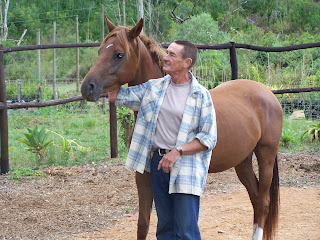Travelling eastward from Stellenbosch one soon comes to wide open stretches of land that support prosperous grain fields. They look very dry and barren at this time of the year because the harvest is largely over and summer is drawing to a close. In the distant north there is always the outline of tall and rugged mountains that mark the beginning of the Karoo, which is not unlike the Australian outback.

Before too many hours have passed one reaches the tranquil town (14 000) of Swellandam, South Africa's third oldest settlement. Stellenbosch had seemed very tame and safe compared to Cape Town; Swellandam is so low key that some of the people don't even lock their doors at night. It was nice to see fewer bars on windows, and less razor wire on fences. To be fair it should be mentioned that the bars are in some areas required to keep out the baboons. Swellendam is set below a small mountain range. Being a traditional Africaaner town, it has many of the Cape Dutch homes that have now become so familiar to us. Swellendam boasts a very fine Dutch Reform church. The streets are extraordinarily wide for such a small centre.

The people that we met at the hostel were a very interesting bunch. About half of them were of various ages from diverse places including a young Israeli couple on their honeymoon and a pair of retired teachers from Paris, France. The owner of the hostel spends most of her time running a horse ranch; many of the guests at the hostel were ferriers and other people who travel from town to town servicing that line of work. Most had thick rural accents which were sometimes hard for us to understand.
After four days we got to know well the main hired hand, Peter, a trainer of some ability who we came to think of as the horse whisperer. He was one of several refugees that we have met from Rhodesia\Zimbabwe that have fled the Mugabe government. A rather sad and lonely man, he often sought our company and talked openly about topics such as having fought in the Rhodesian civil war from 1965-1979, losing the family farm due to land reform policy, the death of his wife, and his two sons who live in New Zealand. He's survived a rather harsh life with "only a few holes" in him (both literal and figurative) but has learned to take life as it comes. Like many Africans, he accepts the "new South Africa" as part of an inevitable evolutionary progress. Peter shared with us how much he enjoyed a couple of brief visits to Canada, especially falling in love with the Edmonton Oilers during the Wayne Gretzky era.

One of the reasons that we stopped at Swellendam was to do some hiking, an appointment with the highly rigorous five-day Otter Trail (never too far from our minds). We're both getting quite dark and adjusting to the heat to the point that we can walk for several hours without too much discomfort. Our first day we headed to Bontebok National Park, six kilometres from the town.
The main attraction was to view the Bontebok antelope, one of the most lovely creatures you'll ever see, that was rescued from the brink of extinction once its numbers had dwindled to less than twenty-five. The animals were easy to see since the park is the smallest in South Africa at just 25 square kilometers. Still, they were quite jittery and moved off until we got down to a picnic area near a river. There we were able to see their immensely beautiful colouring (even in the ears!) up close.

The park is rather bare and dry...meaning snakes abound. The puff adder (a rather lazy serpent that insists that you walk around it ) and the cape cobra are forces to be reckoned with but we didn't have the pleasure of making their acquaintance. We'll get lots of other opportunities though. Did see lots of interesting birds. Hiked along the river for a ways and were in awe of the aloe plants that grow there. Some of them were grouped together in mini-forests that were 8-10 feet high! The one shown in the picture below is a mere infant, but very succulent!

A second and completely different hiking opportunity presented itself nearly on the doorstep of the hostel: the Marloth Nature Reserve. It supposedly still has leopards but it would be miraculous to see one during the day. The flora at the top of the mountain was fabulous. Never knew that red-hot pokers could climb that high. The photos below are of king protea, the national flower, and strawberry everlasting, a kind of fynbos (the main native species) of which protea is a sub-species. We were very interested in these. They look very much like raspberries until the flowers blossom.




We really enjoyed our time in Swellandan, staying in a little cabin off the garden of the hostel. Being in a smaller town makes you feel so much more grounded and able to connect with the locals. Made us think of home. One of the joys of having time to think is reflecting on the people in your life who mean so much. We think of our families and friends daily and trust that you are well.


No comments:
Post a Comment